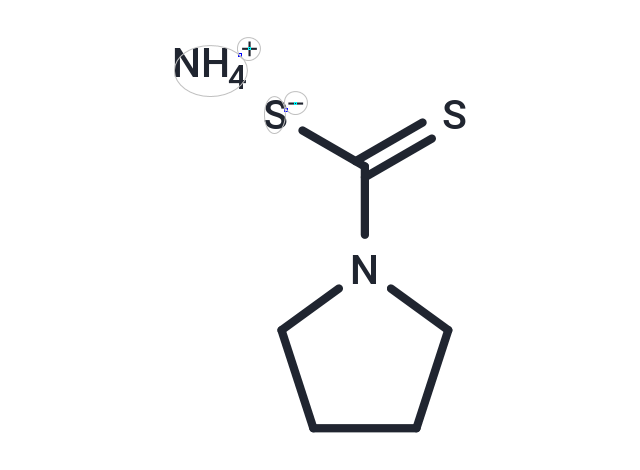Shopping Cart
- Remove All
 Your shopping cart is currently empty
Your shopping cart is currently empty

Pyrrolidinedithiocarbamate ammonium (1-Pyrrolidinedithiocarboxylic acid ammonium salt), a selective NF-κB inhibitor, inhibits translation of nitric oxide synthase mRNA to prevent induction.

| Pack Size | Price | Availability | Quantity |
|---|---|---|---|
| 100 mg | $41 | In Stock | |
| 200 mg | $58 | In Stock | |
| 500 mg | $96 | In Stock | |
| 1 mL x 10 mM (in DMSO) | $39 | In Stock |
| Description | Pyrrolidinedithiocarbamate ammonium (1-Pyrrolidinedithiocarboxylic acid ammonium salt), a selective NF-κB inhibitor, inhibits translation of nitric oxide synthase mRNA to prevent induction. |
| In vitro | Pretreatment of cells with PDTC (3-1000 mM) dose-dependently attenuate IL-8 production. Furthermore, PDTC (100 mM) suppresses the accumulation of IL-8 mRNA. PDTC inhibites the activation of NF-kB, because PDTC suppresses both NF-kB DNA binding and NF-kB-dependent transcriptional activity. Taken together, our data demonstrate that NF-kB inhibition with PDTC decrease IL-8 production by intestinal epithelial cells[1]. |
| In vivo | The DSS+PDTC-treated groupⅡ exhibited suppression of shortening of intestinal length and reduction of DAI score. Activated NF-κB level and IL-1β and TNF-α levels are significantly lower in DSS+PDTC-treated groupⅡ. These findings suggest that suppression of NF-κB activity by PDTC can delay the healing of mucosal tissue defects (erosions or ulcers) arising from inflammation, but that it can strongly suppress the expression of inf-lammatory cytokines (IL-1β and TNF-α), resulting in significant alleviation of colitis. PDTC is useful for the treatment of ulcerative colitis[2]. |
| Kinase Assay | All binding studies are performed in an HTRF assay buffer consisting of dPBS supplemented with 0.1% (with v) bovine serum albumin and 0.05% (v/v) Tween-20. For the PD-l-Ig/PD-Ll-His binding assay, inhibitors are pre-incubated with PD-Ll-His (10 nM final) for 15 m in 4 μL of assay buffer, followed by addition of PD-l-Ig (20 nM final) in 1 μL of assay buffer and further incubation for 15 m. PD-L1 from either human, cyno, or mouse are used. HTRF detection is achieved using europium crypate-labeled anti- Ig (1 nM final) and allophycocyanin (APC) labeled anti-His (20 nM final). Antibodies are diluted in HTRF detection buffer and 5 μL is dispensed on top of binding reaction. The reaction mixture is allowed to equilibrate for 30 minutes and signal (665 nm/620 nm ratio) is obtained using an En Vision fluorometer. Additional binding assays are established between PD-1-Ig/PD-L2-His (20, 5 nM, respectively), CD80-His/PD-Ll-Ig (100, 10 nM, respectively) and CD80-His/CTLA4-Ig (10, 5 nM, respectively). |
| Cell Research | The human colon cancer cell line HT-29 is obtained and cells are grown in modified McCoy's 5A medium supplemented with 10% fetal bovine serum. To study the effect of PDTC on IL-8 production, HT-29 cells in 96-well plates are induced with 20 ng/mL of IL-1b for 18 h. Various concentrations (3-1000 mM) of PDTC or its vehicle (culture medium) are added to the cells 30 min prior to IL-1b stimulation. The concentration of IL-8 in the supernatant is determined using solid-phase enzyme-linked immunosorbent assay, as described previously employing the multiple antibody sandwich principle that specifically detects human IL-8[1]. |
| Alias | PDTC ammonium, APDC, Ammonium pyrrolidinedithiocarbamate, 1-Pyrrolidinedithiocarboxylic acid ammonium salt |
| Molecular Weight | 164.29 |
| Formula | C5H12N2S2 |
| Cas No. | 5108-96-3 |
| Smiles | [NH4+].[S-]C(=S)N1CCCC1 |
| Relative Density. | 1.117 g/cm3 (Estimated) |
| Storage | Powder: -20°C for 3 years | In solvent: -80°C for 1 year | Shipping with blue ice. | |||||||||||||||||||||||||||||||||||
| Solubility Information | DMSO: 75 mg/mL (456.51 mM), Sonication is recommended. | |||||||||||||||||||||||||||||||||||
| In Vivo Formulation | 5% DMSO+95% Saline: 0.6 mg/mL (3.65 mM), Solution. Please add the solvents sequentially, clarifying the solution as much as possible before adding the next one. Dissolve by heating and/or sonication if necessary. Working solution is recommended to be prepared and used immediately. The formulation provided above is for reference purposes only. In vivo formulations may vary and should be modified based on specific experimental conditions. | |||||||||||||||||||||||||||||||||||
Solution Preparation Table | ||||||||||||||||||||||||||||||||||||
DMSO
| ||||||||||||||||||||||||||||||||||||

Copyright © 2015-2025 TargetMol Chemicals Inc. All Rights Reserved.